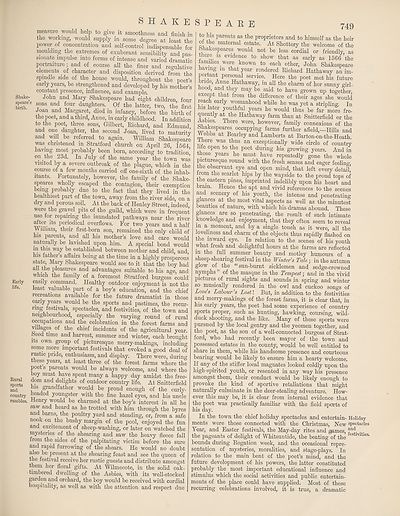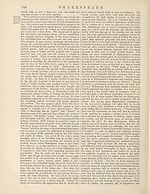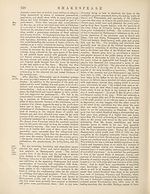Encyclopaedia Britannica > Volume 21, ROT-Siam
(759) Page 749
Download files
Complete book:
Individual page:
Thumbnail gallery: Grid view | List view

kespeare
Shake¬
speare’
birth.
Early
life.
Rural
sports
and
country
rambles,
measure would help to give it smoothness and finish in
the working, would supply in some degree at least the
power of concentration and self-control indispensable for
moulding the extremes of exuberant sensibility and pas¬
sionate impulse into forms of intense and varied dramatic
portraiture; and of course all the finer and regulative
elements . of character and disposition derived from the
spindle side of the house would, throughout the poet’s
early years, be strengthened and developed by his mother’s
constant presence, influence, and example.
John and Mary Shakespeare had eight children four
sons and four daughters. Of the latter, two, the first
Joan and Margaret, died in infancy, before the birth of
the poet, and a third, Anne, in early childhood. In addition
to the poet, three sons, Gilbert, Richard, and Edmund
and one daughter, the second Joan, lived to maturity
and will be referred to again. William Shakespeare
was. christened in Stratford church on April 26, 1564
having most probably been born, according to tradition
on.the 23d. In July of the same year the town was
visited by a severe outbreak of the plague, which in the
course of a few months carried off one-sixth of the inhab¬
itants. Fortunately, however, the family of the Shake-
speares wholly escaped the contagion, their exemption
being probably due to the fact that they lived in the
healthiest part of the town, away from the river side on a
dry and porous soil. At the back of Henley Street, indeed
were the gravel pits of the guild, which were in frequent
use for repairing the inundated pathways near the river
after, its periodical overflows. For two years and a half
William, their first-born son, remained the only child of
his parents, and all his mother’s love and care would
naturally be lavished upon him. A special bond would
in this way be established between mother and child, and
his father s affairs being at the time in a highly prosperous
state, Mary Shakespeare would see to it that the boy had
all the pleasures and advantages suitable to his age, and
which the family of a foremost Stratford burgess could
easily command. Healthy outdoor enjoyment is not the
least valuable part of a boy’s education, and the chief
recreations available for the future dramatist in those
early years would be the sports and pastimes, the recur¬
ring festivals, spectacles, and festivities, of the town and
neighbourhood, especially the varying round of rural
occupations and the celebration in the forest farms and
villages of the chief incidents of the agricultural year.
Seed time and harvest, summer and winter, each brought
its own group of picturesque merry-makings, including
some more important festivals that evoked a good deal of
rustic pride, enthusiasm, and display. There were, during
these years, at least three of the forest farms where the
poet's parents would be always welcome, and where the
boy must have spent many a happy day amidst the free¬
dom and delights of outdoor country life. At Snitterfield
his grandfather would be proud enough of the curly-
headed youngster with the fine hazel eyes, and his uncle
Henry would be charmed at the boy’s interest in all he
saw and heard as he trotted with him through the byres
and barns, the poultry yard and steading, or, from a safe
nook on. the bushy margin of. the pool, enjoyed the fun
and excitement of sheep-washing, or later on watched the
mysteries of the shearing and saw the heavy fleece fall
from the sides of the palpitating victim before the sure
and rapid furrowing of the shears. He would no doubt
also be present at the shearing feast and see the queen of
the festival receive her rustic guests and distribute amongst
them her floral gifts. At Wilmecote, in the solid oak-
tnnbered dwelling of the Asbies, with its well-stocked
garden and orchard, the boy would be received with cordial
hospitality, as well as with the attention and respect due
749
to his parents as the proprietors and to himself as the heir
of the maternal estate. At Shottery the welcome of the
bhakespeares would not be less cordial or friendly, as
there is evidence to show that as early as 1566 the
families, were known to each other, John Shakespeare
having in that year rendered Richard Hathaway an im¬
portant personal service. Here the poet met his future
bride, Anne Hathaway, in all the charm of her sunny girl-
ood, and they may be said to have grown up together,
except that from the difference of their ages she would
reach early womanhood while he was yet a stripling. In
his later youthful years he would thus be far more fre¬
quently at the Hathaway farm than at Snitterfield or the
Asbies. There were, however, family connexions of the
i^akespeares occupying farms further afield,—Hills and
Webbs at Bearley and Lamberts at Barton-on-the-Heath.
Ifiere was thus an exceptionally wide circle of country
i e open to the poet during his growing years. And in
those years he must have repeatedly gone the whole
picturesque round with the fresh senses and eager feeling
the observant eye . and open mind, that left every detail’
from the scarlet hips by the wayside to the proud tops of
the.eastern pines, imprinted indelibly upon his heart and
brain. Hence the. apt and vivid references to the scenes
and scenery of his youth, the intense and penetrating
glances at the most vital aspects as well as the minutest
beauties of nature, with which his dramas abound. These
glances are so penetrating, the result of such intimate
knowledge and enjoyment, that they often seem to reveal
m a . moment, and by a single touch as it were, all the
loveliness and charm of the objects thus rapidly flashed on
the inward eye. In relation to the scenes of his youth
what fresh and delightful hours at the farms are reflected
m the full, summer beauty and motley humours of a
sheep-shearing festival in the Winter’s Tale; in the autumn
glow of, the “ sun-burnt sicklemen and sedge-crowned
nymphs of the masque in the Tempest', and in the vivid
pictures of rural sights and sounds in spring and winter
so musically rendered in the owl and cuckoo songs of
Love s Labour s Lost! But, in addition to the festivities
and merry-makings of the forest farms, it is clear that, in
his early years, the poet had some experience of country
sports proper, such as hunting, hawking, coursing, wild-
duck shooting, and the like. Many of these sports were
pursued by the local gentry and the yeomen together, and
the poet, as the son of a well-connected burgess of Strat¬
ford, who had recently been mayor of the town and
possessed estates in the county, would be well entitled to
share in them, while his handsome presence and courteous
bearing would be likely to ensure him a hearty welcome.
If any of. the stiffer local magnates looked coldly upon the
high-spirited youth, or resented in any way his presence
amongst them, their conduct would be likely enough to
provoke the kind of sportive retaliations that might
naturally culminate in the deer-stealing adventure. How¬
ever this may be, it is clear from internal evidence that
the poet was practically familiar with the field sports of
his day.
In the town the chief holiday spectacles and entertain- Holiday
ments were those connected with the Christmas, Hew spectacles
Year, and Easter festivals, the May-day rites and games, . .
the pageants of delight of Whitsuntide, the beating of the estlvlties-
bounds during Rogation week, and the occasional repre¬
sentation of mysteries, moralities, and stage-plays. In
relation to the main bent of the poet’s mind, and the
future development of his powers, the latter constituted
probably the most important educational influence and
stimulus which the social activities and public entertain¬
ments, of the place could have supplied. Most of these
recurring celebrations involved, it is true, a dramatic
Shake¬
speare’
birth.
Early
life.
Rural
sports
and
country
rambles,
measure would help to give it smoothness and finish in
the working, would supply in some degree at least the
power of concentration and self-control indispensable for
moulding the extremes of exuberant sensibility and pas¬
sionate impulse into forms of intense and varied dramatic
portraiture; and of course all the finer and regulative
elements . of character and disposition derived from the
spindle side of the house would, throughout the poet’s
early years, be strengthened and developed by his mother’s
constant presence, influence, and example.
John and Mary Shakespeare had eight children four
sons and four daughters. Of the latter, two, the first
Joan and Margaret, died in infancy, before the birth of
the poet, and a third, Anne, in early childhood. In addition
to the poet, three sons, Gilbert, Richard, and Edmund
and one daughter, the second Joan, lived to maturity
and will be referred to again. William Shakespeare
was. christened in Stratford church on April 26, 1564
having most probably been born, according to tradition
on.the 23d. In July of the same year the town was
visited by a severe outbreak of the plague, which in the
course of a few months carried off one-sixth of the inhab¬
itants. Fortunately, however, the family of the Shake-
speares wholly escaped the contagion, their exemption
being probably due to the fact that they lived in the
healthiest part of the town, away from the river side on a
dry and porous soil. At the back of Henley Street, indeed
were the gravel pits of the guild, which were in frequent
use for repairing the inundated pathways near the river
after, its periodical overflows. For two years and a half
William, their first-born son, remained the only child of
his parents, and all his mother’s love and care would
naturally be lavished upon him. A special bond would
in this way be established between mother and child, and
his father s affairs being at the time in a highly prosperous
state, Mary Shakespeare would see to it that the boy had
all the pleasures and advantages suitable to his age, and
which the family of a foremost Stratford burgess could
easily command. Healthy outdoor enjoyment is not the
least valuable part of a boy’s education, and the chief
recreations available for the future dramatist in those
early years would be the sports and pastimes, the recur¬
ring festivals, spectacles, and festivities, of the town and
neighbourhood, especially the varying round of rural
occupations and the celebration in the forest farms and
villages of the chief incidents of the agricultural year.
Seed time and harvest, summer and winter, each brought
its own group of picturesque merry-makings, including
some more important festivals that evoked a good deal of
rustic pride, enthusiasm, and display. There were, during
these years, at least three of the forest farms where the
poet's parents would be always welcome, and where the
boy must have spent many a happy day amidst the free¬
dom and delights of outdoor country life. At Snitterfield
his grandfather would be proud enough of the curly-
headed youngster with the fine hazel eyes, and his uncle
Henry would be charmed at the boy’s interest in all he
saw and heard as he trotted with him through the byres
and barns, the poultry yard and steading, or, from a safe
nook on. the bushy margin of. the pool, enjoyed the fun
and excitement of sheep-washing, or later on watched the
mysteries of the shearing and saw the heavy fleece fall
from the sides of the palpitating victim before the sure
and rapid furrowing of the shears. He would no doubt
also be present at the shearing feast and see the queen of
the festival receive her rustic guests and distribute amongst
them her floral gifts. At Wilmecote, in the solid oak-
tnnbered dwelling of the Asbies, with its well-stocked
garden and orchard, the boy would be received with cordial
hospitality, as well as with the attention and respect due
749
to his parents as the proprietors and to himself as the heir
of the maternal estate. At Shottery the welcome of the
bhakespeares would not be less cordial or friendly, as
there is evidence to show that as early as 1566 the
families, were known to each other, John Shakespeare
having in that year rendered Richard Hathaway an im¬
portant personal service. Here the poet met his future
bride, Anne Hathaway, in all the charm of her sunny girl-
ood, and they may be said to have grown up together,
except that from the difference of their ages she would
reach early womanhood while he was yet a stripling. In
his later youthful years he would thus be far more fre¬
quently at the Hathaway farm than at Snitterfield or the
Asbies. There were, however, family connexions of the
i^akespeares occupying farms further afield,—Hills and
Webbs at Bearley and Lamberts at Barton-on-the-Heath.
Ifiere was thus an exceptionally wide circle of country
i e open to the poet during his growing years. And in
those years he must have repeatedly gone the whole
picturesque round with the fresh senses and eager feeling
the observant eye . and open mind, that left every detail’
from the scarlet hips by the wayside to the proud tops of
the.eastern pines, imprinted indelibly upon his heart and
brain. Hence the. apt and vivid references to the scenes
and scenery of his youth, the intense and penetrating
glances at the most vital aspects as well as the minutest
beauties of nature, with which his dramas abound. These
glances are so penetrating, the result of such intimate
knowledge and enjoyment, that they often seem to reveal
m a . moment, and by a single touch as it were, all the
loveliness and charm of the objects thus rapidly flashed on
the inward eye. In relation to the scenes of his youth
what fresh and delightful hours at the farms are reflected
m the full, summer beauty and motley humours of a
sheep-shearing festival in the Winter’s Tale; in the autumn
glow of, the “ sun-burnt sicklemen and sedge-crowned
nymphs of the masque in the Tempest', and in the vivid
pictures of rural sights and sounds in spring and winter
so musically rendered in the owl and cuckoo songs of
Love s Labour s Lost! But, in addition to the festivities
and merry-makings of the forest farms, it is clear that, in
his early years, the poet had some experience of country
sports proper, such as hunting, hawking, coursing, wild-
duck shooting, and the like. Many of these sports were
pursued by the local gentry and the yeomen together, and
the poet, as the son of a well-connected burgess of Strat¬
ford, who had recently been mayor of the town and
possessed estates in the county, would be well entitled to
share in them, while his handsome presence and courteous
bearing would be likely to ensure him a hearty welcome.
If any of. the stiffer local magnates looked coldly upon the
high-spirited youth, or resented in any way his presence
amongst them, their conduct would be likely enough to
provoke the kind of sportive retaliations that might
naturally culminate in the deer-stealing adventure. How¬
ever this may be, it is clear from internal evidence that
the poet was practically familiar with the field sports of
his day.
In the town the chief holiday spectacles and entertain- Holiday
ments were those connected with the Christmas, Hew spectacles
Year, and Easter festivals, the May-day rites and games, . .
the pageants of delight of Whitsuntide, the beating of the estlvlties-
bounds during Rogation week, and the occasional repre¬
sentation of mysteries, moralities, and stage-plays. In
relation to the main bent of the poet’s mind, and the
future development of his powers, the latter constituted
probably the most important educational influence and
stimulus which the social activities and public entertain¬
ments, of the place could have supplied. Most of these
recurring celebrations involved, it is true, a dramatic
Set display mode to:
![]() Universal Viewer |
Universal Viewer | ![]() Mirador |
Large image | Transcription
Mirador |
Large image | Transcription
Images and transcriptions on this page, including medium image downloads, may be used under the Creative Commons Attribution 4.0 International Licence unless otherwise stated. ![]()
| Encyclopaedia Britannica > Encyclopaedia Britannica > Volume 21, ROT-Siam > (759) Page 749 |
|---|
| Permanent URL | https://digital.nls.uk/193637146 |
|---|
| Attribution and copyright: |
|
|---|---|
| Shelfmark | EB.17 |
|---|---|
| Description | Ten editions of 'Encyclopaedia Britannica', issued from 1768-1903, in 231 volumes. Originally issued in 100 weekly parts (3 volumes) between 1768 and 1771 by publishers: Colin Macfarquhar and Andrew Bell (Edinburgh); editor: William Smellie: engraver: Andrew Bell. Expanded editions in the 19th century featured more volumes and contributions from leading experts in their fields. Managed and published in Edinburgh up to the 9th edition (25 volumes, from 1875-1889); the 10th edition (1902-1903) re-issued the 9th edition, with 11 supplementary volumes. |
|---|---|
| Additional NLS resources: |
|

